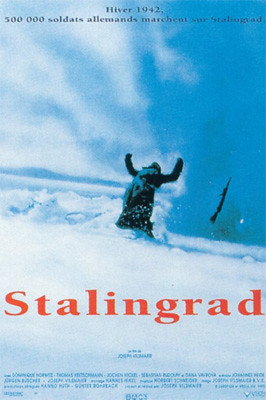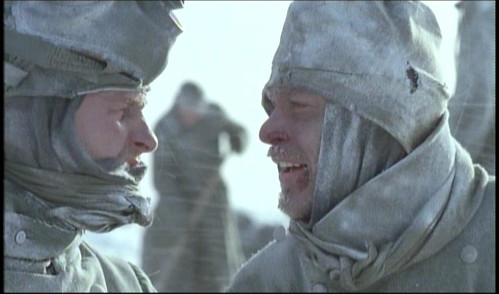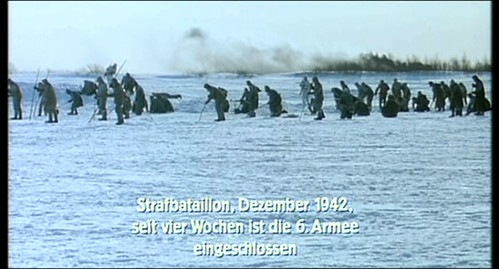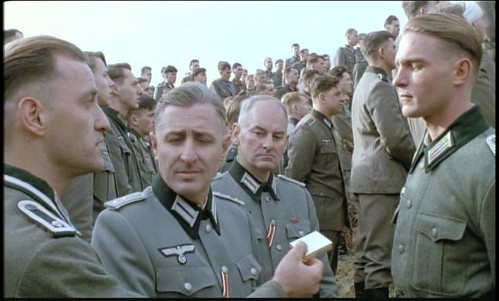Stalingrad (1992) * * * *
 (Link to the Stalingrad DVD at Amazon)
(Link to the Stalingrad DVD at Amazon)Stalingrad (now Volgograd) lies on the Volga River in southern Russia. It was a major transit point for oil and supplies for the Russian army in World War II, and here the Russian and German armies fought the deadliest battle in WWII, if not in human history. The final defeat of the Germans at Stalingrad marked the turning of the war on the Eastern front. Both sides sought to win regardless of the cost, with wanton disregard for civilian and military life. Stalin went so far as to forbid civilians from fleeing the city in order to deepen the resolve of the city’s defenders. Both sides forbid retreat by the soldiers, on the threat of immediate execution. The final tally of dead from this battle is incomprehensible. On the German side, some ¾ of a million troops were involved and basically all were killed or wounded, except some 6,000 who were taken POWs and managed to survive Siberian work camps. On the Russian side, some 1 ¾ million troops were involved and about half were killed or wounded. To put things in perspective, the number of soldiers killed in the 199 days of the battle of Stalingrad well exceed all American military deaths in WWI, WWII, the Korean War and the Vietnam War combined. Estimates place the total number killed or wounded, military plus civilian, at 1 ½ to 2 million people.
 The film follows a company of German soldiers, storm troopers, who have just finished fighting in Africa and are sent to the battle for Stalingrad. The film focuses on a group of about 6 of these men from this company (well, the core focus group starts larger but their numbers keep getting smaller). We see them as they arrive in the midst of the battle. They step off the train into hell, walking past a long line of severely wounded men and Russian POWs being beaten to death. Less than an hour after their arrival, they are in intense close urban combat. I cannot say how realistic these scenes are, but they are certainty some of the most gripping that I have watched. But they are not heroic pictures of combat. It’s ugly, scary and men soil their pants. As the movie goes on we follow this core group through battles, an overly harsh punishment involving loss of rank and work on mine removal, the deepening chaos of the German army as they are surrounded, desperate battles against the Russian tanks, and finally the collapse of the German army in Stalingrad.
The film follows a company of German soldiers, storm troopers, who have just finished fighting in Africa and are sent to the battle for Stalingrad. The film focuses on a group of about 6 of these men from this company (well, the core focus group starts larger but their numbers keep getting smaller). We see them as they arrive in the midst of the battle. They step off the train into hell, walking past a long line of severely wounded men and Russian POWs being beaten to death. Less than an hour after their arrival, they are in intense close urban combat. I cannot say how realistic these scenes are, but they are certainty some of the most gripping that I have watched. But they are not heroic pictures of combat. It’s ugly, scary and men soil their pants. As the movie goes on we follow this core group through battles, an overly harsh punishment involving loss of rank and work on mine removal, the deepening chaos of the German army as they are surrounded, desperate battles against the Russian tanks, and finally the collapse of the German army in Stalingrad.I’m not really into war-movies. There is generally far too much testosterone involved for my liking. But I do spend a bit of time in Central Europe and I am intrigued by differences in the social and political perspectives of Americans versus Europeans, and especially differences in views about war. Two incredibly bloody wars (WWI and WWII) were fought on European soil. The war was especially destructive to the populations in Central and Eastern Europe.
 The percent of the total population killed in WWII was approximately 10% across Central & Eastern Europe, with Poland and the Soviet Union on the high end with ca 15% of the population killed, Germany in the middle at 10% of the population killed and Czechoslovakia on the low end with 2.5% killed. In contrast outside of Central & Eastern Europe (UK, France, Spain, Belgium, Norway, Denmark, Spain, etc), approximately 1% of the population was killed with France on the high end at 1.3%. So I wanted to watch the film to gain a deeper understanding of the impact of war on this region.
The percent of the total population killed in WWII was approximately 10% across Central & Eastern Europe, with Poland and the Soviet Union on the high end with ca 15% of the population killed, Germany in the middle at 10% of the population killed and Czechoslovakia on the low end with 2.5% killed. In contrast outside of Central & Eastern Europe (UK, France, Spain, Belgium, Norway, Denmark, Spain, etc), approximately 1% of the population was killed with France on the high end at 1.3%. So I wanted to watch the film to gain a deeper understanding of the impact of war on this region.I had approached this film with some trepidation since other reviews had said that it is extremely graphic. I had expected close ups of limbs being blow off and intestines hanging out. However, relative to Saving Private Ryan and Downfall (which I also saw recently), I did not find it particularly gruesome. Let me clarify that, this is a film that attempts to show a deadly battle in a realistic light. There is a lot of blood. Men get limbs blown off. There are dead bodies everywhere. But I did not find the gore gratuitous. For example, there are no close-ups of men with their faces half blown off or intestines hanging out. Although I winced in many places, there was no scene like the beach landing in Saving Private Ryan that I that I felt ill watching.
 One of the things that struck me in Stalingrad was the portrayal of the German officers as cruel to the German soldiers. Traitors (those that try to escape by injuring themselves) are summarily executed. A high level officer hoards a warehouse of food while the soldiers starve. We see a scene where dead soldiers are being burned in a big bon fire. The camera lingers for a moment as a dead soldier is thrown onto the burning stack. A group of soldiers threaten a doctor to get care for their friend and are court-marshaled and sent to work on land mine removal. Much like in Downfall, there is a sense that the common solider is there simply to be slaughtered. Individual life is not valued, and soldiers have meaning only in aggregate as little flags that are moved around a map as a division. However, in Downfall this sense of the soldier as mere cannon-fodder comes mainly from Hitler and the generals find this view appalling, whereas in Stalingrad there are high-level generals on the ground with this attitude. In fact, one of the generals in Stalingrad is so nasty, cruel and cowardly, he seems to have been cast from Indian Jones and the Lost Ark. In Downfall, this is not the case, the generals are uniformly professional, courageous and dedicated to the troops. Nonetheless, one detects, like in Downfall, a seething anger about WWII and about the enormous casualties of young German men. Towards the end, one soldier berates an officer who objects that "I'm not a Nazi", that he is worse than a Nazi because he went along with them even knowing how it was going to end.
One of the things that struck me in Stalingrad was the portrayal of the German officers as cruel to the German soldiers. Traitors (those that try to escape by injuring themselves) are summarily executed. A high level officer hoards a warehouse of food while the soldiers starve. We see a scene where dead soldiers are being burned in a big bon fire. The camera lingers for a moment as a dead soldier is thrown onto the burning stack. A group of soldiers threaten a doctor to get care for their friend and are court-marshaled and sent to work on land mine removal. Much like in Downfall, there is a sense that the common solider is there simply to be slaughtered. Individual life is not valued, and soldiers have meaning only in aggregate as little flags that are moved around a map as a division. However, in Downfall this sense of the soldier as mere cannon-fodder comes mainly from Hitler and the generals find this view appalling, whereas in Stalingrad there are high-level generals on the ground with this attitude. In fact, one of the generals in Stalingrad is so nasty, cruel and cowardly, he seems to have been cast from Indian Jones and the Lost Ark. In Downfall, this is not the case, the generals are uniformly professional, courageous and dedicated to the troops. Nonetheless, one detects, like in Downfall, a seething anger about WWII and about the enormous casualties of young German men. Towards the end, one soldier berates an officer who objects that "I'm not a Nazi", that he is worse than a Nazi because he went along with them even knowing how it was going to end.Stalingrad is considered one of the great anti-war films about WWII. It is anti-war in that it does not glamorize war and exposes the ludicrousness of the Reich propaganda about “Fuhrer, Volk, Vaterland, and the hero’s death”. The would-be German hero dies with soiled pants, screaming from his shredded legs – just like the Russian hero dying while crying for his mother. It is a bitter picture of war. Although Stalingrad is well-regarded for its general realism, it seems to take some liberties by using protagonists that are curiously not racists. The common German view of Slavs in this period was decidedly racist (see for the documentary Mein Krieg), and if one believes the footage from Mein Krieg and the Soviet movies on the Eastern front, Germans were regularly killing civilians – who they regarded as sub-humans and whores. So the scene where the soldiers are stunned that they are ordered to kill civilians who are collaborating with the Russian army seems unbelievable. And that the German officer would defend the Russian boy, who was obviously helping the Russian soldiers in an earlier fight, is also implausible.
Nonetheless, I personally found Stalingrad to be a deeply moving movie, and overall, I recommend it to anyone who liked movies like Das Boot, Downfall or Saving Private Ryan. This is no "pound the chest" war movie. There is no glory in this war-film. After watching it I sat on the bed of my sleeping young son for a long time, and almost cried imagining the millions of mothers that had to send their sons to war, never to return.
To see reviews of other movies and books on the Eastern Front, click here: Eastern Front. Other WWII reviews can be found by clicking the tags in the right navbar.
-----------------------
Rented from Netflix.
My epinions review of Stalingrad.
Labels: Eastern Front, Germany, Russian, WWII

<< Home